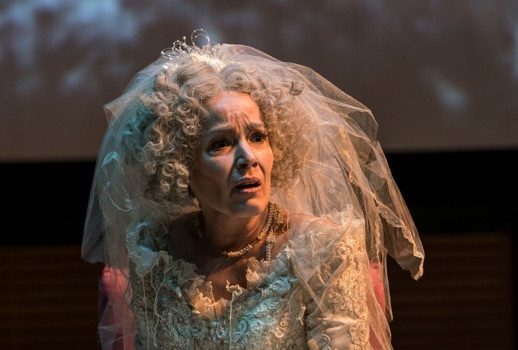

But what are we going to do with all this Chicken à la King?
You don’t hear his name very often nowadays, but in the seventies and eighties Dominick Argento (who turned ninety this year) was one of the most oft-performed of American opera composers. He represented a change from the excessively scholastic and atonal schools, the composers who had no idea how to write for the human voice or how to make vocal drama attractive.
However, unlike the the tuneful operas of the fifties, of Barber and Douglas Moore and Carlisle Floyd (which seem, happily, to be returning to favor lately), he used modern harmonic techniques, rhythmic variations and a witty touch of pastiche—lots of pastiche—to enliven his storytelling. He was of his own time but he did not turn his back on the past.
There is something playful about Argento’s avant-gardism, and genuine humor in such works as A Postcard from Morocco (once a staple of conservatory opera programs), Casanova’s Homecoming and The Aspern Papers. He wrote a great deal of vocal music, and got it performed more often than once. But very little of it has endured as long as he has.
The New York City Opera is ambitiously reviving itself, it seems, by shooting arrows in as many of the company’s traditional directions as it can. They fall to earth I know not where, but sometimes land in a happy target or an old friend. NYCO gave itself a showy event and a salute to the company’s past by celebrating Argento’s birthday with a staging in his presence, at Zankel Hall last Thursday, of two of the composers once somewhat popular monodramas.
Miss Havisham’s Wedding Night (often known as Miss Havisham’s Fire, but actually just one section of Argento’s full-length Dickensian grand opera, a major City Opera flop in 1979) is a grand soprano mad scene, supposedly set in the lady’s hermetic parlor, scene of her disastrous jilting. The endearing Chekhovian satire, A Water Bird Talk, is a piece for tenor and small orchestra. To a New York audience that barely remembers or is completely unacquainted with them, the two mini-operas proved intriguing and colorful entertainments.
The musicians were choice. Heather Buck has a full-throated coloratura soprano, a womanly sound to soothe ears lately jounced by Audrey Luna. Her attention to expression, to abrupt changes of crazy mood, to inserted flutters of mad laughter (are these noted in the score or optional?) recalled many a Mad Lucia, from Joan to Bubbles to Vera Galupe-Borzkh—and perhaps Cathy Berberian in her purple Erté gown. Argento might have named it “Misimpressions of Lucia.” He does that sort of thing. I loved the onstage “hotel orchestra” in Postcard from Morocco that played reminiscences of Wagner in an endearingly wrong-note manner.
But Buck’s vocal and histrionic talents fell short on the matter of diction. I know you will snort, What about Joan’s diction? But we already knew every word Joan was singing, and she made them gorgeous even when indecipherable. With Miss Havisham, we do not know what she is nattering on about, there was neither text nor titling to help us. Too much of the time Buck’s hysterical murmurs and minces gave us little clue.
The performance therefore compared unfavorably to those I’ve heard of Peter Maxwell Davies’ Eight Songs for a Mad King (texts taken from the ravings of George III), a work that is said in the program to have inspired Argento’s. The diction in Eight Songs has usually been quite clear and the chamber setting is careful never to get in its way. I could not tell if the tiny orchestra at Miss Havisham was too loud for Buck (whose voice seems quite enjoyably sizable) or if she simply did not give her attention to the matter.

The crazy room and its dilapidation were nicely implied, complete with sofa and grandfather clock—though would Miss H really have an American flag prominently displayed in her boudoir? There was no mouse-ridden wedding cake. I believe Rose erred in bringing on Miss Havisham’s parlor maid and her ward, Estella—they do not sing and are probably imaginary. They distracted our attention from Miss Buck’s acting.
A Water Bird Talk, which I had not heard before, was highly regarded when it was brand new (in 1976), because it was beguiling to hear, a charming workout for a lyric tenor (without being rough on his technique) and humorous. All great humor must push the edge of pain, and the lecturer’s story is a sad one.
As he explains the habits of water birds (illustrated by J.J. Audubon slides from a primitive projector), the contrast with his own dreary married life provide a view of his quiet, if not silent, desperation, of his contemptuous wife and house full of unmarriageable daughters, each of them born on the thirteenth of whatever month it was. He is henpecked, and rather sympathizes with the cormorants, puffins and grebes.
Water Bird is rather more varied, less self-consciously arch than its companion. The Gentleman Lecturer was sung with fine lyric tenor line and superb diction by Aaron Engebreth, at the same time acting the self-conscious milquetoast with furtive but insistent power. Any gifted lyric tenor would delight in such a workout, but Engebreth’s smooth clarity left nothing to be desired.
Here Maestro Rose had rather more to work with orchestrally, bird effects and weirdly harmonized quasi-Victorian tunes (hymns, waltzes), and a lot of percussion to depict birds in flight, offstage harrumphs from the speaker’s wife and a slow demolition of a personality. The prim staging, which included a long scene of phony piano playing as Mr. Engebreth endeavored to gentle his injured feelings and Argento had pastiche Schubert performed in the pit, created a very satisfying team effect between singer and instrumentalists.
Photos: Sarah Shatz

























Comments